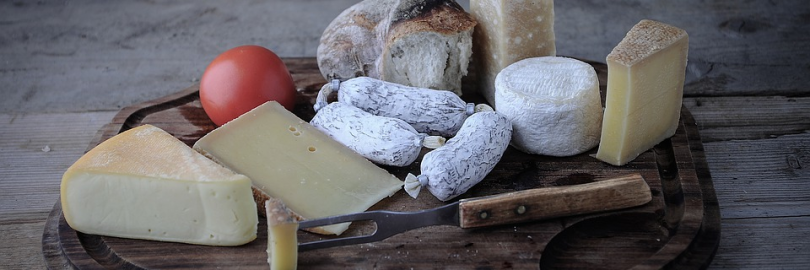
The Complete Cheese Guide 2024: 6 Types of Cheeses and Their Uses
Cheese is difficult to classify because there are so many different styles.Even for cheese lovers, scanning a store’s cheese counter can be a very overwhelming experience.Every cheese starts with the same four ingredients: milk (usually from cows, goats, or sheep), plus salt, culture, and enzyme.Those basic ingredients can yield fascinatingly different cheeses.How many types of cheeses are there?Which type of cheese is the best?How do you pick a good cheese?The easiest way is to get a general understanding of six basic types of cheese. Keep reading this cheese guide, and you’ll find your favorite type of cheeses.
Because cheese is such an ancient ingredient that's prepared in different ways by cultures all over the world, it's difficult to estimate how many types of cheese there are. We can say for sure that there are thousands of types of cheese; in the country of France alone, some people estimate that there are over 1,000 distinct varieties of cheese!
Since there are so many individual types of cheese, it's useful to group them based on shared characteristics. Below, cheeses are classified into six different types based on texture: fresh, soft, semi-soft, semi-hard, hard, and blue-veined.
Fresh chesses

Fresh cheese is the common name for cheeses made from fresh curds that have not been pressed or aged. Produced throughout the world and commonly used in cooking, fresh cheese is a leaner substitute for cream. Texture varies here depending on how the paste is introduced into the world, but the taste is usually mild, slightly acidic, and only lending a small hint of flavor. Since fresh cheese has the highest moisture content, the pure fromage can be rolled in various herbs, spices, crumbled nuts, cut fruit, and even edible flowers.Some of the different cheeses in this category include:
1. Feta
This fresh cheese originally hails from Greece, where it was traditionally made from sheep’s or goat’s milk. this Greek delicacy delights in its tangy and somewhat salty notes, along with a creamy and almost crumbly texture.
Depending on the region where it’s made, the flavor, texture, and aroma varies – from soft, creamy and nearly hole-less, to intense, robust, and sometimes dry. It’s one of the best cheese varieties for salads and pasta tosses.
Type of Milk: Sheep and goat
Flavor Notes: Tangy, salty, pungent, intense
Texture: Brittle, dry, grainy
Wine: Rose
Accompaniments: Cucumber, tomato, red onions
2. Cream Cheese
A cream of light texture and pliability where it was made from cow’s milk,this cheese delivers mild and decadent sensations in every dish. Its flavours are soft, with a soothing balance of slightly acidic notes to compensate. It is often mixed with garlic or herbs to add piquancy to its milder make-up.Pair with pasta dishes, rye bread and a sharp white wine or wheat beer.
Type of Milk: Cow
Flavor Notes: Mild, milky, slightly acidic, rich
Texture: Thick, homogenous, creamy, spreadable
Accompaniments: Scallions, chives, poppy seeds, roasted garlic, black pepper, honey, mint, dried cranberries, orange zest, dark chocolate
3. Mozzarella
Usually made from cow’s milk, fresh mozzarella has a mild, milky flavor and soft texture,accompanied by a light aroma of rich cream.Moist and velvety when fresh, the consistency becomes stringy and molten with a taste that slowly softens as it melts.It’s one of summer’s most popular cheeses, especially when served with sliced homegrown tomatoes, fresh basil, salt, pepper, and olive oil, a treat known as caprese.Fresh and dairy rich, mozzarella is prized for its texture and mild creamy flavor.Pair with tomatoes, basil, olive oil and red wine.
Type of Milk: Buffalo or cow
Flavor Notes: Mild, milky, slightly acidic
Texture: Creamy, elastic
Wine: Soave, or any red or white
Accompaniments: Olive oil, tomatoes, basil, grilled vegetables
4. BURRATA
Balanced, mild and beautifully unique, Burrata is more than just a twist on Mozzarella. When cut open, the creamy centre is revealed as it soothingly seeps from the cover of its soft shell. Smooth, fresh and with a delightful clash of textures, it seduces with its decadent and mellow nature.
Type of Milk: Buffalo or cow
Flavor Notes: Mild, milky, slightly acidic
Texture: Creamy, elastic
Wine: Soave, or any red or white
Accompaniments: tomatoes, olive oil, basil and honeydew
5. Mascarpone
This soft, rich, and buttery cheese from Italy is made from cow’s milk. It’s the best cheese for making tiramasu, and is also great with fresh fruit.
Type of Milk: Cow
Flavor Notes: Slightly sweet, rich, buttery, slightly tangy
Texture: Spreadable, creamy
Accompaniments: Strawberries, chocolate shavings, honey, in or spooned on top of desserts
6. Chèvre
The French word chèvre literally translate to "goat," and is used to refer to any cheese made from goat's milk. Colloquially in America, however, chèvre refers exclusively to fresh goat's milk cheese, it is unaged and eaten almost immediately after it is made. Fresh chèvre tends to be moist, bright and acidic, with a lemony flavor and slightly chalky finish in the mouth. You'll find it sold in vacuum sealed logs, sometimes flavored with herbs, spices, or garlic.
Type of milk: Goat
Flavor Notes: Slightly sweet, rich, buttery, slightly tangy
Texture: Spreadable, creamy
Accompaniments: herbs, spices, or garlic,crumbled in salads, breaded and fried, in sandwiches, in macaroni and cheese
Soft Cheeses

Ripened anywhere between 0-30 days, soft cheeses contain a high moisture content, a usually higher fat content, and therefore has a more pudding-like paste.Often found on a cheese board, these types of cheese become luscious and fuller in flavor when served at room temperature.
Some of the different cheeses in this category include:
1. Brie and Camembert
These two cheese names might sound familiar—their rich, mild, and creamy appeal make them among the most popular cheeses for serving at parties! These cow’s milk cheeses are also the best cheese candidates for serving warm and wrapped in pastry crust.

2. Chaource
Chaource is a soft cheese made from cow’s milk in the village of Chaource, France. This cylindrical shaped cheese has a soft-ripened, creamy and a little bit crumbly, non-elastic texture. Surrounded by a white velvety rind, it's ageing process lasts between 2 weeks to 2 months. Many people like to eat young Chaource when its rind is hardly formed whereas others eat after it attains full maturation.
During its ageing time, the cheese has a bit salty, buttery and milky taste. Together with 25% fat, it also contains animal rennet.
Type of Milk: Cow
Flavor Notes: Buttery, mild
Texture: A bit drier than other soft cheeses, sturdy, middle can slide out if cut open and left at room temp for a couple hours
Wine: Chablis, Sancerre, or Champagne
Accompaniments: Baguette, fig jam
Semi-Soft Cheeses

Treading into the denser, earthier, and the tiniest bit more pungent-tasting, semi-soft cheeses are lightly pressed into molds to create a more rubbery outer texture, but leaving a delicate, custardy, soft center. Semi-soft cheese has a higher moisture content compared to harder cheese, and it also tends to have a milder taste.
Some of the different cheeses in this category include:
1. Havarti
This traditional Danish cheese has a buttery yet tangy flavor and melts nicely for sandwiches and sauces. It’s also a good candidate for a cheese board—its mild flavor will balance out more assertive cheeses.
Type of Milk: Cow
Flavor Notes: Cultured butter, slightly acidic, and sharp
Texture: Smooth, creamy, elastic
Wine: Chardonnay, Sauvignon Blanc, Pinot Noir
Accompaniments: Figs, raisins, walnuts, rustic breads
2. Muenster
American Muenster is a rich, mild cheese. Because it melts incredibly well, it’s one of the most popular cheeses for grilled cheese sandwiches. Do not confuse American Muenster with French Munster, which is a boldly flavored washed-rind cheese.
Type of Milk: Cow
Flavor Notes: Mild, sweet, roasted nuts
Texture: Smooth, soft, supple
Beer / Wine: Gewurztraminer, Riesling, Belgian ales, lagers, porters, stouts
Accompaniments: Apples, dried fruits, pears, beef
3. American Process Cheese
Because American cheese is made with additives not usually found in other types of cheese, it’s labeled a “process cheese.” The smooth, mild, semisoft cheese melts well, making it a favorite for macaroni and cheese, grilled cheese sandwiches, and to top burgers—especially for the under-10 crowd.
Type of Milk: Blend of cow's milk, milk fats and solids, and whey protein
Flavor Notes: Mild and salty
Texture: Homogenous and creamy
Beer: American-style IPAs
Accompaniments: Crusty breads, bacon, tomatoes, Muenster, Havarti, and Provolone cheese
4. Provolone
This cow’s milk cheese originated in Italy. It tastes mild when young, and grows sharper as it’s aged. Sliced thin, young provolone is one of the best cheese choices to use in sandwiches—it goes with everything!
Type of Milk: Cow
Flavor Notes: Beefy, sharp, nutty, salty undertones
Texture: Smooth, silky, firm
Beer / Wine: Chianti, Pinot Grigio, Lagers
Accompaniments: Carpaccio, toasted bread, dried plums, cherries, olives, roasted red peppers, giardinera
5. Taleggio
At over a thousand years old, Taleggio is one of the world's oldest soft cheeses. The washed rind cheese is in a family of cheeses created by monks who made cheese from the milk of their grazing cows in order to eliminate waste. Taleggio smells sort of like... feet. Rich, buttery, meaty, feet. Its soft rind is edible, though it acquires a grainy texture from its repeated wash with salty brine.
Type of Milk: Cow
Flavor Notes: Meaty, tangy, pungent
Texture: Rubbery, pliant
Wine: Saison, Pinot Noir, Rose
Accompaniments: Mustard, honey, chestnuts, polenta
Semi-Hard Cheeses
A perfect balance of moisture and aridity, these cheeses provide a firm, slightly springy texture with a delicate blend of savoury and tangy flavours. Usually dense in consistency, the cheese is often made by compressing curds into a solid, draining them of any remaining whey in the process.
Semi-hard cheeses start to take on more developed notes, ranging anywhere between more floral, more fruity, and even developing an aroma of freshly browned butter. Semi-firm is not meant for grating or spreading, but rather shredding or slicing.
Some of the different cheeses in this category include:
1. Cheddar
Cheddar is a cow's milk cheese that originated in Somerset, England. Hardly ever in need of introduction, this English treasure has become a permanent resident in global cuisine."to cheddar" refers to a cheesemaking process whereby the curds of the cow's milk are cooked and then milled into rice-size pieces. The pieces are then pressed into large blocks, and the blocks are stacked one on top of another to press out any remaining moisture. Cheddar cheese made in this traditional fashion are dry and crumbly in texture, with a deep, tangy, nutty flavor.
Type of Milk: Cow
Flavor Notes: Umami, sharp, bold, toasted hazelnuts, whiskey
Texture: A bit crumbly
Beer / Wine: Zinfandel, Pinot Noir, Cabernet, porter, mead, or amber ale
Accompaniments: Cherries, apples, walnuts, cashews, dill crackers
2. Gouda
Gouda is a semi-hard to hard cow's milk cheese from Holland. Like Cheddar, its quality and flavor can vary wildly from the mild, creamy wax-coated lunchbox versions of our youth to those specimens that are hard, crumbly, and deeply flavorful. Long-aged goudas will have a crunchy texture due to crystals of concentrated calcium lactate or and the amino acid tyrosine that form as the cheese loses moisture, just like a good parmesan.As it ages, flavours become more piquant and the texture crystallises.
Type of Milk: Cow or Goat
Flavor Notes: Intense, caramel / butterscotch flavor, browned butter, toffee
Texture: Semi-dry, a bit crunchy, definitive bite
Wine: Cabernet or Shiraz
Accompaniments: Spicy nuts, olives, oat crackers
3. Gruyère
A cheese plastered in history and tradition, Gruyère acquires its flavours from rich cow’s milk. The texture is flaky and granular with age, with younger variants being denser. Revealing full-bodied, fruity tones, the flavours slowly journey towards nutty and earthy with a mild finish.Pair with berry jam, sliced pear and grapes.
Type of Milk: Cow
Flavor Notes: Sweet, slightly salty, complex, slightly earthy, beefy
Texture: A bit grainy and flaky, dense
Wine: Spanish Sherries or southern France reds
Accompaniments: Broiled on top of onion soups, baked into heartier dishes, sliced pears, lingonberry jam, figs, rosemary, marjoram
4. Edam
Recognized by its red, wax packaging, Edam is a semisoft cheese with a mild tangy and slightly salty flavor. Though it’s satisfying as a snack, it’s a bit too mild to stand out on a cheese board.
Type of Milk: Cow or goat
Flavor Notes: Competing blends of creamy and nutty tones, hint of salt
Texture: Springy and dense
Wine: Pinot Grigio, Riesling, Chardonnay, Shiraz
Accompaniments: Peaches, apricots, cherries, melons
Hard Cheeses

As the name suggests, hard cheese is firm. Best for grating or thinly slicing, this dry-textured cheese takes away the thick-cut meltability you'd get from fresh to semi-firm varietals, but gives back a potent, deeply savory flavor that is incomparable to any other type of cheese.
Most hard cheeses develop a natural and tough rind, amassing an abundance of flavour over time. Too hard to eat on their own, the rinds add decadence and strata when mixed into soups, sauces and stews.
Some of the different cheeses in this category include:
1. Parmigiano-Reggiano
Crowned the king of cheeses, this Italian pure-blood is sharp, intense and full-bodied in taste. The texture is firm when young, becoming granular and crystallised as it ages. It is one of the best cheese choices for risotto and for grating as a finishing touch to pasta.There are a number of hard cheeses on the market that are sold under the name "parmesan." These are not to be confused with true Parmigiano-Reggiano, a protected cheese that can only be produced in Emilia-Romagna and Lombardia in Italy.
Type of milk: Cow
Flavor Notes: Crunch,Deep Caramel-y, Nutty Flavors
Texture: Hard, Dry, Crumbly
Wine: Champagne,Sparkling Wine
Accompaniments: Walnuts, Zesty
2. Manchego
Made from the milk of Manchega sheep, it's a firm, compact cheese that ranges in color from ivory to straw yellow.It is nutty, with light touches of sweet fruit and spice. The use of sheep’s milk allows for a richer, creamier consistency that grows granular and flaky as the seasons pass.Enjoy it on a cheese board before dinner, or for dessert with bread and cherry preserves.
Type of Milk: Sheep
Flavor Notes: Creamy, tangy, semi-sweet, salty after taste, well-developed
Texture: Flaky, grainy, and slightly crystalized
Beer / Wine: Stout, Porter, Sherry, Riesling, Whiskey
Accompaniments: Honey, almonds, marmalade
3. Pecorino
This Italian classic, made using fresh milk from sheep, has been produced in the same way for over two millennia.
Pecorino has distinctively salty and peppery flavors; a little goes a long way to add so much flavor to pastas and salads. Note that American-produced Romano cheeses are different cheeses altogether—they’re produced from cow’s milk and not nearly as full-flavored.
Type of Milk: Sheep
Flavor Notes: Aromatic, pungent, soft spices
Texture: Crumbly, firm
Wine: White Burgundy, Nebbiolo, Pinot Noir, Rioja
Accompaniments: Dry-cured meats, walnuts, hearty, winter vegetables, sausages
4. Grana Padano
The texture, taste and appearance of Grana Padano is often mistaken for that of Parmigiano-Reggiano. Even so, this mighty Italian cheese certainly holds its own against its close relative. Slightly milder, the body is less granular, only requiring 9 months of maturation.Pair with fresh apples, figs and honey.
Type of Milk: Cow
Flavor Notes: Full-bodied, savory
Texture: Dense, flaky, rickety, crunchy
Wine: Gavi, Chianti, Barbaresco, Barolo, Lambrusco, Amarone
Accompaniments: Figs, dried fruits, honey, apples, arugula or lacinato kale salads, add the rind into soup
Blue-Veined Cheeses
The most complex of all the cheeses, blue-veined gives you the best of both worlds: rich and creamy like a soft cheese, yet pungent and perfumed like a firm.These types of cheese have distinctive blue veins created by the addition of a helpful mold during the cheese-making process. The flavor ranges from mild to assertive to quite pungent.
Some of the different cheeses in this category include:
1. Gorgonzola
This cow’s milk cheese from Italy has a rich, slightly pungent flavor that becomes stronger as it ages. Partner it with pears and apples on a cheese board, or crumble it over potatoes.
Type of Milk: Cow
Flavor Notes: Competing flavors of buttery and piquant
Texture: Soft yet crumbly
Wine: Zinfandel and Sauternes
Accompaniments: Grapes, honey, pistachios
2. Fourme d'Ambert
This AOC (name controlled) creamy blue cheese is a lovely French treasure with a cylindrical shape. Fourme d'Ambert is high in moisture and compact in texture, so the blue mould does not spread in veins like other Blues, rather it forms in distinct, disconnected pockets. Compared to Blue Stilton, it is much creamier and therefore less crumbly. Fourme d'Ambert is cave-aged for a minimum of two months, made from raw cow’s milk and has a tremendous, creamy, full-bodied flavor.
Type of Milk: Cow
Flavor Notes: Creamy, earthy, smooth, balanced
Texture: Velvety, supple, dense
Wine: Merlot, Port, Riesling
Accompaniments: Baguette, rye bread, raisins, walnuts, hazelnuts, figs, raspberries, cherries
3. Roquefort
A blue mould cheese made from sheep’s milk, this French classic is complex and intense. Its body is moist and laced with small blue pockets, providing a blend of sharp and tangy nuances. Vibrant and full of character, Roquefort made blue mould cheeses popular for a reason.
Type of Milk: Sheep
Flavor Notes: Pungent, sweet burnt caramel, metallic tang
Texture: Moist, soft, crumbly, cratered
Wine: Riesling, Port, Sherry, or ice wines
Accompaniments: Honey, spiced apples, meat
4. Stilton
Less moist than other blue mould cheeses, Stilton is strong and intense.The creamy yet slightly crumbly texture of this English cheese makes it especially good alone or served with port or dry red wine.
Type of Milk: Cow
Flavor Notes: Robust, strong, earthy, mushroomy, grassy, peppery
Texture: Creamy, loose crumb
Beer / Wine: Porter, Stout, Sherry, Elderberry, Cabernet Sauvignon
Accompaniments: Honey, pecans, roasted red peppers, meat and fish, nut bread
Money Saving Tips:
When you buy cheeses online, don't forget to sign up at Extrabux (What is Extrabux?). Then you will have a chance to get up to 30% super cashback & access to thousands of money-saving coupons from Extrabux ! Sign-Up Bonus: Free to join it & get $20 welcome bonus!
Important Cheese Criteria to Know
Country of Origin: The country where the cheese was first developed. In some cases, the name of the cheese is protected, meaning that unless it is produced via strictly controlled methods in a specific region of the world, it cannot bear the name. Roquefort or Manchego are examples of cheeses like this. Other cheeses originate from a certain area but are now produced around the world. Gouda is an example of such a cheese. In general, the latter type of cheese will vary in quality far more than a protected cheese.
Type of milk: Cheese always starts with milk, but the animal it comes from can make a profound difference on its final flavor. Cow's milk is the mildest, with a creamy, sweet flavor that translates into a more subtle base flavor in the cheese, so aging and ripening play a prominent role in the development of flavor in these cheeses. Sheep's milk has a mild grassy flavor with a tangier backbone and less buttery sweetness than cow's milk. Goat's milk is the gamiest of all, with a definite hay/barnyard funk to it.
Aging: Most cheeses are aged for a period of time in a temperature-controlled environment. During this process, moisture evaporates leading to a denser paste and a more intense flavor. Bacteria get to work inside the cheese slowly digesting proteins and converting the texture of a cheese from grainy and crumbly to smooth and creamy (eventually, as enough moisture leaves, a cheese can become grainy and crumbly again, like in a good parmesan). Bacteria on the exterior also play a role in developing a rind and enhancing flavor.
Different Cheeses for Different Uses
Best Types of Cheese for Grating: Cheese names that come top of mind when it’s time to add a finely grated finishing touch to soups, salads, and pasta dishes include aged Asiago, Pecorino Romano, Manchego, and Parmagiano-Reggiano.
Best Types of Cheese for Slicing: Because they’re sliceable and melt well, the following are some of the more popular cheeses for sandwiches, both grilled and cold: American, brick, cheddar, Colby, Edam, Gouda, Gruyère, Havarti, Monterey Jack, mozzarella, American Muenster, provolone, and Swiss.
Best Types of Cheese for Shredding and Melting: When it comes time to make a cheese sauce, macaroni and cheese, a cheesy casserole, or pizza, get out the shredder and reach for one of these types of cheese that shred and melt well: American, cheddar, Colby, Comté, Gouda, Gruyère, Jarlsberg, Monterey Jack, mozzarella, American Muenster, provolone, and Swiss.
With hundreds of cheeses now available at the grocery store and in cheese shops, buying cheese can be downright intimidating. Just follow these simple guidelines. You'll never be nervous about buying cheese again.
Ask yourself a few questions:
Do you usually like soft, creamy cheeses or firmer ones? Or both?
Do you like strong cheeses?
Do you like salty and/or blue cheeses?

Extrabux is an international cashback shopping site, offering up to 30% cashback from 10,000+ Stores!
Squarespace, SkinStore, MATCHESFASHION, The Wall Street Journal, NordVPN, Visible, Armani Exchange, Sam's Club, PUMA, AliExpress, Card Cash, NET-A-PORTER, Udacity, Udemy, Selfridges, LOOKFANTASTIC, Vimeo, Coach Outlet, lululemon, PrettyLittleThing, Booking.com, Ripley's Aquarium, iHerb, Groupon, etc.
Join to get $20 welcome bonus now! (How does Welcome Bonus work?)
Recommendation
-

10 Best & Stylish Winter Coats for Women on NET-A-PORTER in 2024
-

Top 12 Items That Are Always Cheaper at Sam's Club!
-

Top & Best 12 Sneaker Apps/Websites for Raffles, Releases & Restocks in 2024
-

7 Best Gift Card Exchange Sites - Buy, Sell and Trade Discount Gift Card Safely and Instanly!
-

Top 9 Professional Skincare Brands for Licensed Estheticians 2024











